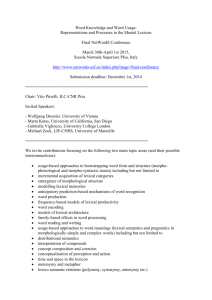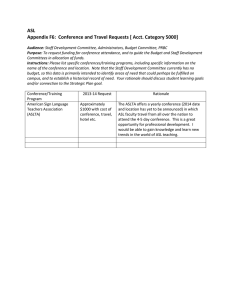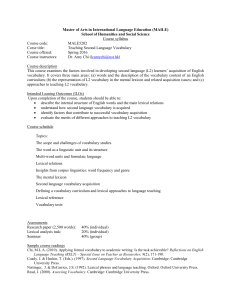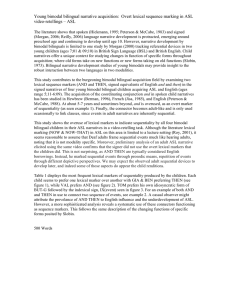This sociolinguistic case study of a multi-generational Deaf family of... “Lexical Variation and Change in American Sign Language:
advertisement
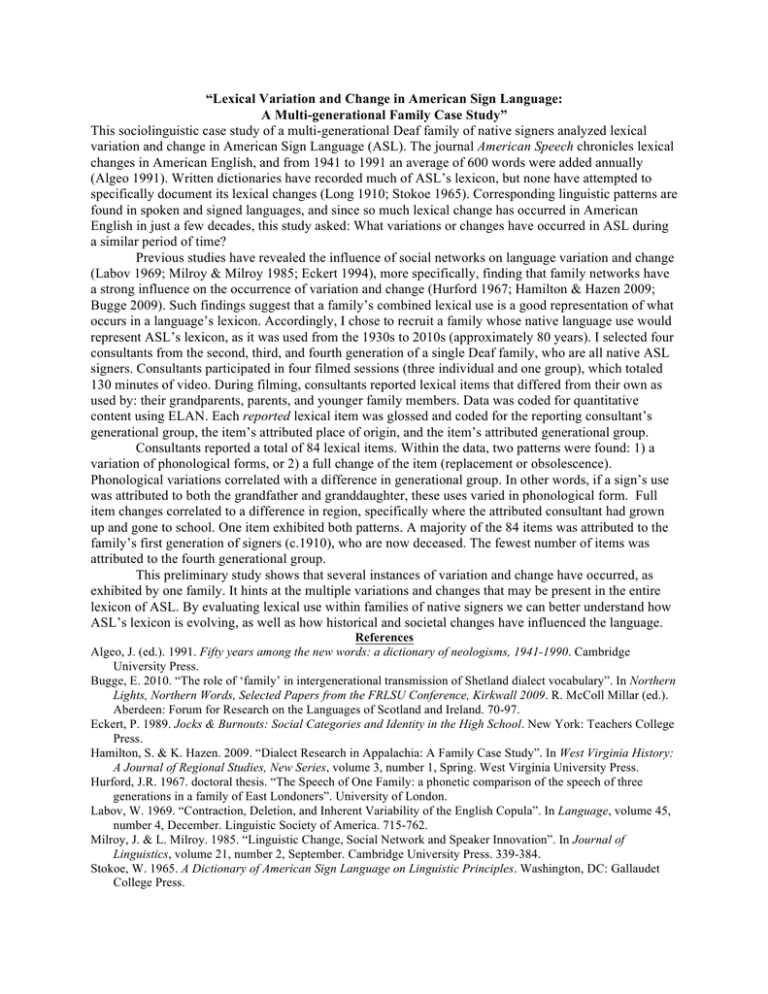
“Lexical Variation and Change in American Sign Language: A Multi-generational Family Case Study” This sociolinguistic case study of a multi-generational Deaf family of native signers analyzed lexical variation and change in American Sign Language (ASL). The journal American Speech chronicles lexical changes in American English, and from 1941 to 1991 an average of 600 words were added annually (Algeo 1991). Written dictionaries have recorded much of ASL’s lexicon, but none have attempted to specifically document its lexical changes (Long 1910; Stokoe 1965). Corresponding linguistic patterns are found in spoken and signed languages, and since so much lexical change has occurred in American English in just a few decades, this study asked: What variations or changes have occurred in ASL during a similar period of time? Previous studies have revealed the influence of social networks on language variation and change (Labov 1969; Milroy & Milroy 1985; Eckert 1994), more specifically, finding that family networks have a strong influence on the occurrence of variation and change (Hurford 1967; Hamilton & Hazen 2009; Bugge 2009). Such findings suggest that a family’s combined lexical use is a good representation of what occurs in a language’s lexicon. Accordingly, I chose to recruit a family whose native language use would represent ASL’s lexicon, as it was used from the 1930s to 2010s (approximately 80 years). I selected four consultants from the second, third, and fourth generation of a single Deaf family, who are all native ASL signers. Consultants participated in four filmed sessions (three individual and one group), which totaled 130 minutes of video. During filming, consultants reported lexical items that differed from their own as used by: their grandparents, parents, and younger family members. Data was coded for quantitative content using ELAN. Each reported lexical item was glossed and coded for the reporting consultant’s generational group, the item’s attributed place of origin, and the item’s attributed generational group. Consultants reported a total of 84 lexical items. Within the data, two patterns were found: 1) a variation of phonological forms, or 2) a full change of the item (replacement or obsolescence). Phonological variations correlated with a difference in generational group. In other words, if a sign’s use was attributed to both the grandfather and granddaughter, these uses varied in phonological form. Full item changes correlated to a difference in region, specifically where the attributed consultant had grown up and gone to school. One item exhibited both patterns. A majority of the 84 items was attributed to the family’s first generation of signers (c.1910), who are now deceased. The fewest number of items was attributed to the fourth generational group. This preliminary study shows that several instances of variation and change have occurred, as exhibited by one family. It hints at the multiple variations and changes that may be present in the entire lexicon of ASL. By evaluating lexical use within families of native signers we can better understand how ASL’s lexicon is evolving, as well as how historical and societal changes have influenced the language. References Algeo, J. (ed.). 1991. Fifty years among the new words: a dictionary of neologisms, 1941-1990. Cambridge University Press. Bugge, E. 2010. “The role of ‘family’ in intergenerational transmission of Shetland dialect vocabulary”. In Northern Lights, Northern Words, Selected Papers from the FRLSU Conference, Kirkwall 2009. R. McColl Millar (ed.). Aberdeen: Forum for Research on the Languages of Scotland and Ireland. 70-97. Eckert, P. 1989. Jocks & Burnouts: Social Categories and Identity in the High School. New York: Teachers College Press. Hamilton, S. & K. Hazen. 2009. “Dialect Research in Appalachia: A Family Case Study”. In West Virginia History: A Journal of Regional Studies, New Series, volume 3, number 1, Spring. West Virginia University Press. Hurford, J.R. 1967. doctoral thesis. “The Speech of One Family: a phonetic comparison of the speech of three generations in a family of East Londoners”. University of London. Labov, W. 1969. “Contraction, Deletion, and Inherent Variability of the English Copula”. In Language, volume 45, number 4, December. Linguistic Society of America. 715-762. Milroy, J. & L. Milroy. 1985. “Linguistic Change, Social Network and Speaker Innovation”. In Journal of Linguistics, volume 21, number 2, September. Cambridge University Press. 339-384. Stokoe, W. 1965. A Dictionary of American Sign Language on Linguistic Principles. Washington, DC: Gallaudet College Press.


